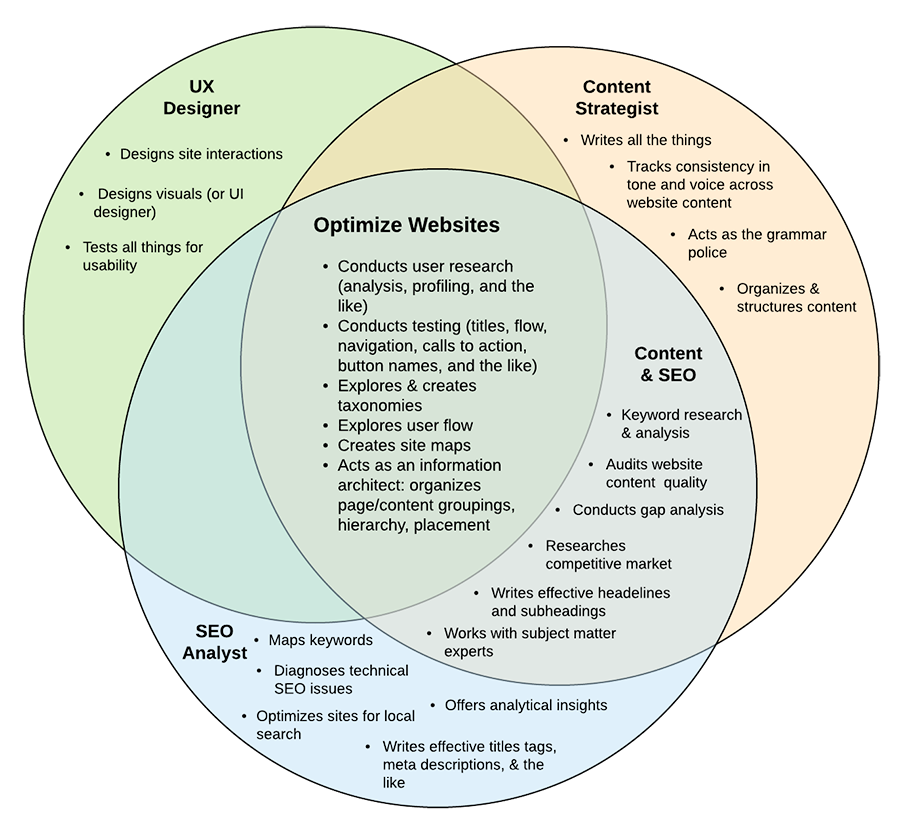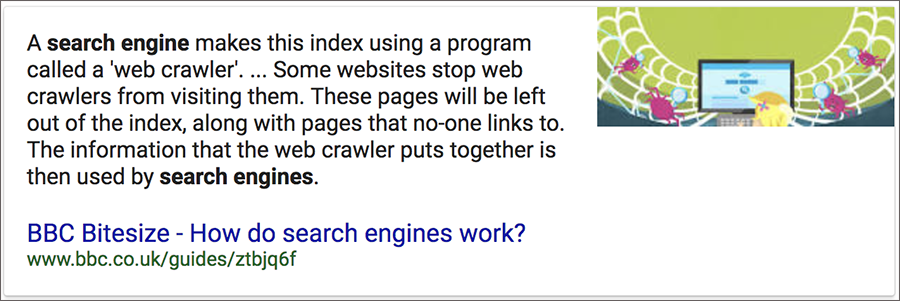A Musing on the Age-Old Question: Who Does What, When, & With Whom?
Question for you: What’s your job title? And now next question: What do you actually do? I find navigating the area of job roles and responsibilities rather interesting. In a recent conversation with my colleague about what constitutes the SEO’s responsibilities as opposed to the content strategist’s, we were both a little stymied—there was a lot of overlap!
Where does your yellow brick road go compared to mine?
Who’s responsible for what, when, and with whom? And where does your yellow brick road go compared to mine? I’m gonna’ dig into this a little deeper and see if I can find any answers (preferably ones I like…).
The Who
Content Strategists: Front-End & Back End
A content strategist, in the words of strategist Ann Rockley writing for the Content Marketing Institute, “come[s] in two main types: front-end and back-end.”* The front-end strategists “typically have a love for the content and the customer experience. They make recommendations about the content itself.”
According to Rockley, this could include answering questions like these (paraphrased):
- Who’s our target audience?
- What content do they need most?
- How well do we meet those needs and how can we do it better?
Back-end strategists “have a love for structure, scalability, and technology.”
They answer questions like these (paraphrased):
- How is content organized and delivered (what is the taxonomy)?
- What content governance processes do we use so that our content is not duplicate or redundant?
- How do we customize this content modularly to best match the user’s needs?
One of the things I love best about content is the structuring, organizing, delivering, and processes. Who doesn’t want to make sure it’s all structured beautifully (also called information architecture^) and that it’s sorted in the most effective way?
Interestingly, this differs slightly from the description of a content specialist. After perusing job descriptions for a content specialist, I found these main defining points:
- Create written content for web
- Optimize that content for SEO
- Research keywords and apply to content
- Write blog/articles, do site updates, post content
- Provide/research marketplace competitive analysis
- Organize and structure content (information architecture)
- Do other tasks related to content development
Next up, those search engine optimizers.
SEO Analysts
A search engine optimization analyst or specialist or consultant, or just plain SEO, “analyzes and reviews websites and their incoming links in order to provide expert advice, guidance, and recommendations…seeking to earn more natural search engine traffic and higher ranking positions.”** This involves things like:
- Web page optimization
- Keyword research and analysis
- Keyword mapping
- Focus on user experience
- Diagnosing technical SEO issues
- Auditing websites
- Optimizing sites for local search
- Completing online competitive analysis
- Writing effective headlines, subheadings, title tags, meta descriptions, and the like
- Improving existing website content
- Creating the sitemap
- Numerous other things
What I see here, and what I’ve experienced, is that an SEO has a keener understanding of the data surrounding web metrics and how to interpret this data. They also understand information architecture, competitive analysis (obviously), and technical website function in order to improve the quality of websites.
UX Experts
The descriptions I have found for this specialty are, interestingly, the most nebulous. Here is a great definition I found from UX Designer:
“…the term UX designer describes a wide ranging responsibility to ensure that an end product achieves its core (often business) objectives whilst providing its users with the most effective, efficient and enjoyable experience as possible.”
The definition of a UX expert is the most nebulous.
More granularly, this might break down to skills defined by these roles:
- UX Researcher (user analysis & profiling plus other insight gathering and planning activities)
- Information architect (page/content groupings, hierarchy, placement)
- Interaction designer or UI designer (related but not the same interface creation focused roles)
- Visual designer (brings the interfaces to life from an aesthetic/brand/creative perspective; some overlap with UI designer)
- Usability testing expert (ideally provides a continuous user feedback loop allowing timely updates to design thinking)^^
The blog post What is UX Design? 15 User Experience Experts Weigh In on User Testing Blog has some interesting thoughts from several user experience experts.
Of course, if you want to get real-time with this, you can also examine the more recent rush to list positions for UX writers. UX Booth has this article showing job listings from Amazon, Dropbox, and Paypal (all the cool kids are doing it…).
If you made it through all those job descriptions, I’m impressed! Now in this who’s-doing-it, let’s examine how everything works together—or if it does.
The What
Now that we’ve got all the players, let’s take a look at the cross-overs between responsibilities. I’ve created this nifty Venn diagram to illustrate the patterns I’m seeing:
That’s a lottttttttt of overlap. And I don’t think any one area ultimately owns any one of the shared tasks.
The When
So when do these experts work together, and do you need all of them on your yellow brick road? I think it all depends on what you are trying to achieve and the skill sets you have on your team. From my experience, collaboration between job roles is the best way to achieve a great product (or perhaps it’s just my preferred working method?).
The overlap between content, SEO, and UX is considerable.
There must be a product owner who represents the user (and there’s another wrench to throw into the mix…), but the product owner should not dictate the methods or tactics used by the experts/specialists (and this includes all of the above: content strategist and specialists, the SEOs, and the UX peeps). This leaves the experts to think about and analyze user needs and craft a product to meet those needs.
The best thing you can do for your experts and specialists, IMO, is to clearly define roles. I work pretty amicably with my co-workers, and many of our skill sets overlap, but sometimes it helps to understand who is handling what, if only for organization’s sake.
As Marcus Buckingham and Curt Coffman write in their book First Break All the Rules: What the World’s Greatest Managers Do Differently, the key to having happy employees, successful employees is (in part) ensuring they know the answers to these questions:
- Do I know what is expected of me at work?
- At work do I have the opportunity to do what I do best every day?***
I also recommend spending time actually trying to understand what your employees do before either hiring more people or assuming you know the extent of their work. It’s possible they are already doing things you aren’t even aware of that match the skill sets you think you need. It’s equally possible to give an employee the chance to get training and grow to fulfill a need you think you have.
Where does your yellow brick road go and with whom? Who do you all work with to craft your products? What are their titles compared with their roles and how do they overlap? Do your experts know where they are going?
Lemme’ know if you’d care to. I’d love to hear more about how these skill sets work together in other organizations and what you think the essence of each role is.
*Why You Need Two Types of Content Strategist https://contentmarketinginstitute.com/2016/02/types-content-strategist/
^”Information architecture (IA) focuses on organizing, structuring, and labeling content in an effective and sustainable way.” It also involves these things:
- Organization Schemes and Structures: How you categorize and structure information
- Labeling Systems: How you represent information
- Navigation Systems: How users browse or move through information
- Search Systems: How users look for information
Source: Information Architecture Basics https://www.usability.gov/what-and-why/information-architecture.html
**What Does An SEO Consultant Do? http://www.contentmarketingspot.com/search-engine-optimization/what-does-an-seo-consultant-do/ via @seoincolorado
^^ Also from UX Designer http://www.userexperiencedesigner.co.uk/new-what-is-ux-designer-ia.htm
***There are 10 more of these Qs, but I think you get the gist. And read the book. It’s not half bad.




